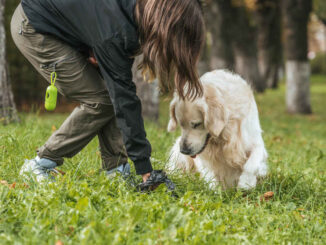
This article was updated on August 31st, 2023

Scooping doggy poop is a fact of life for a dog parent. As pet owners, we are used to picking up after our pups twice or even three times a day. But what we aren’t accustomed to is seeing blood in dog waste. Naturally, noticing bloody dog poop can be quite the jolting experience! But what if your dog appears to be fine and is acting normal?
Today, Senior Tail Waggers goes over what to do if your dog’s poop contains blood, but they are otherwise acting normal.
My Dog is Pooping Blood But Has No Other Symptoms. What’s Going On?
An adult dog or puppy can have bloody stools for a variety of reasons. Some causes are minor, while others require immediate veterinary attention. A dog who has no other symptoms (such as crying/whining, limping, obvious physical trauma, etc.) may behave normally. They eat, drink, and play. Yet during potty time, their feces are visibly red in color.
Chances are, it could be due to:
1. Eating Something Unsuitable
Have you ever heard the term “garbage gut?”
This refers to the harsh reaction a dog’s stomach has after eating trash, which can include poop that contains blood. Since it takes time for food to be digested, you may not see a change in your dog’s habits. They could gobble down heaps of rotten table scraps, as well as meat offcuts, bones, plastic wrapping, bathroom tissues/toilet paper, etc., and show zero signs.
Until it comes out of their hind end, that is!
If your dog has bloody stools but is still acting normal, it’s possible that they are hiding their tummy troubles. Or perhaps vomiting and nausea haven’t fully hit them yet.
2. Hemorrhoids or Rectal Injuries
Does your pooch love the dog park? Do they spend hours hiking in the woods? What about running around the sandy beach?
These are all fun, dog-friendly activities. However, accidents happen.
Your dog could scratch their bum area on a sharp surface or ingest a jagged stick or bone in a split second. Unless you see it occur, how would you know? When they have a bowel movement, this is when blood may appear. Dog owners should pay attention to the firmness and shape of the poop. If it looks normal (and your dog is still acting playful and happy), then it’s plausible a surface injury is the problem. Check their anal area for cuts, swelling, or protrusions.
Similarly, bloody stools are the #1 indicator of hemorrhoids. A dog might feel uncomfortable and drag their bottom across the floor. Or lick their bum. Owners could assume this is normal dog behavior, so it’s important to do a full physical inspection whenever you see blood in your dog’s poop.
That way, you’ll know for sure what is normal and what isn’t!
3. Parasites
As disgusting as parasites like roundworms, hookworms, and whipworms are, the good news is these are highly treatable. You will likely notice right away if your dog’s behavior changes due to parasites. But for people who a) recently got a new puppy or b) adopted a dog from a shelter or rescue, it’s harder to pinpoint any additional symptoms. For example, weight loss, lack of appetite, and low energy could be mistakenly attributed to stress. When, in fact, it’s those nasty worms!
So, if a dog has a bloody stool and no other “obvious” symptoms, ask yourself, “How well do I really know this dog? Could they maybe have parasites?”
4. Tumors / Cancer
Third, a dog’s poop can contain blood – even if they are acting normal – because of cancer. Anytime there is a tumor in the digestive tract, it can result in bloody feces. Yet until you have a positive diagnosis, it’s impossible to know for sure if cancer is to blame.
Sadly, cancer often goes undetected in dogs. They can act mostly normal for weeks or even months before other signs show up.
Different Types of Bloody Dog Poop
Now, as unpleasant as it is, knowing about dog feces is a lifesaving skill. There are half a dozen different types of bloody dog poop. It won’t all look the same. In all cases, it’s advised you call your veterinarian for medical guidance. To see pictures, visit Blood in my Dog’s Poop: A Vet Shares What to Do.
- Bright Red Blood: Generally speaking, bright red blood indicates a lower digestive system issue. Think hemorrhoids, colonic irritation, or colitis.
- Bright Red Bloody Streaks: A dog who has poop that is streaked with lines of blood (and is not entirely red in color) could be suffering from a wide range of issues. Anything from mild irritation and anal gland problems to much more serious tumors. If streaky feces only happen once or twice…try to relax. This shouldn’t be too concerning, so long as it isn’t a regular occurrence and isn’t accompanied by any other worrisome symptoms, like vomiting and pain.
- Raspberry Jam/Jelly Blood in a Dog’s Poop: Ew, right? Despite this strong visual imagery (sorry about that!), there’s no better way to describe this kind of bloody stool. Wet, slimy red poops could indicate inflammation of the digestive tract. So, if your dog’s poop looks like raspberry jam…call the vet. Even if they are acting normal, this is a sign they should be checked out, as it’s the opposite of what firm, healthy brown stools look like.
- Black, Tarry Poop (Melena). Of all the bloody dog poops, this one is the trickiest to spot. That’s because, unlike bright red blood, dark brown and black blood blends in. Before getting to this point, a dog will usually have other symptoms, such as vomiting, weight loss, food refusal, etc. Still, it’s worth repeating: even normal-acting dogs can suffer from stomach ulcers, inflammation in the stomach or small intestine, and cancer in the upper digestive system that results in black, tarry feces. Any dog can mask their discomfort.
Is Blood in Dog Poop an Emergency If My Dog is Acting Normal?
The rule of thumb is this: a dog who only mildly poops blood once is nothing to freak out over.
A dog who poops blood frequently, in large amounts, or that is clearly in distress during bowel movements needs to be seen by a vet, ASAP even if they are acting normal and present no other medical symptoms.
What to do If Your Dog is Pooping Blood But Behaving Normal
Depending on the cause, blood in a dog’s poop may clear up on its own.
Still, as their loving fur parent, you’re looking for ideas to help them feel better. If your dog isn’t vomiting, pacing, crying, etc. then you have some options. First, watch their bowel movements for 24 – 48 hours. Check the color and texture of their feces – but don’t touch it! Report your finding to your vet and await further instructions.
Remember to also leave out food and water.
Take your pooch outside for lots of bathroom breaks. If they seem happy and content, hopefully the bloody stools will fade quickly.
Home Remedies to Help your Dog
Seeing blood in dog’s poop can be scary, it’s important to know that not all bloody dog poop is an emergency. Mild cases can even be treated at home with some not-so-secret remedies that we’ll let you in on – with the help of your veterinarian ( it’s important to consult your veterinarian before trying any treatment):
- Rest: When something is off in the body, the best medicine is rest and relaxation.
- Stay hydrated: Offer your dog plenty of fresh and clean options or or mix in a little low-sodium chicken broth or unflavored Pedialyte.
- Withhold food: Give your dog’s digestive system a break by withholding food for about 12 hours. This will just allow what’s in there to move out without adding additional work.
- Bland diet: After the initial 12 hours of withholding food, get their digestive system back up and running with some boiled chicken and rice-no seasonings. Read our article featuring 11 easy bland diet options for dogs.
- Probiotics: Replenish your dog’s microbiome with probiotics. Fortiflora and Probios are good options as they are specifically designed for dogs.
- Fiber: Boosting your dog’s fiber can help your dog’s digestive tract move things through. Canned pumpkin or low-sodium canned green beans are a great way to incorporate a little more fiber.
Most mild cases of bloody stools in dogs will resolve within 24-48 hours. Learn more: Vet-Approved Home Remedies For Blood in a Dog’s Stool / Poop.
Final Thoughts
As yucky as it is, you will likely see blood in your dog’s poop at times. Even the most obedient and healthiest of dogs get into the garbage from time to time. Luckily, they have you! Now you know precisely what to do when your dog is acting normal, but their poop contains blood.
Related posts:
Disclaimer: This website's content is not a substitute for veterinary care. Always consult with your veterinarian for healthcare decisions. Read More.










Be the first to comment